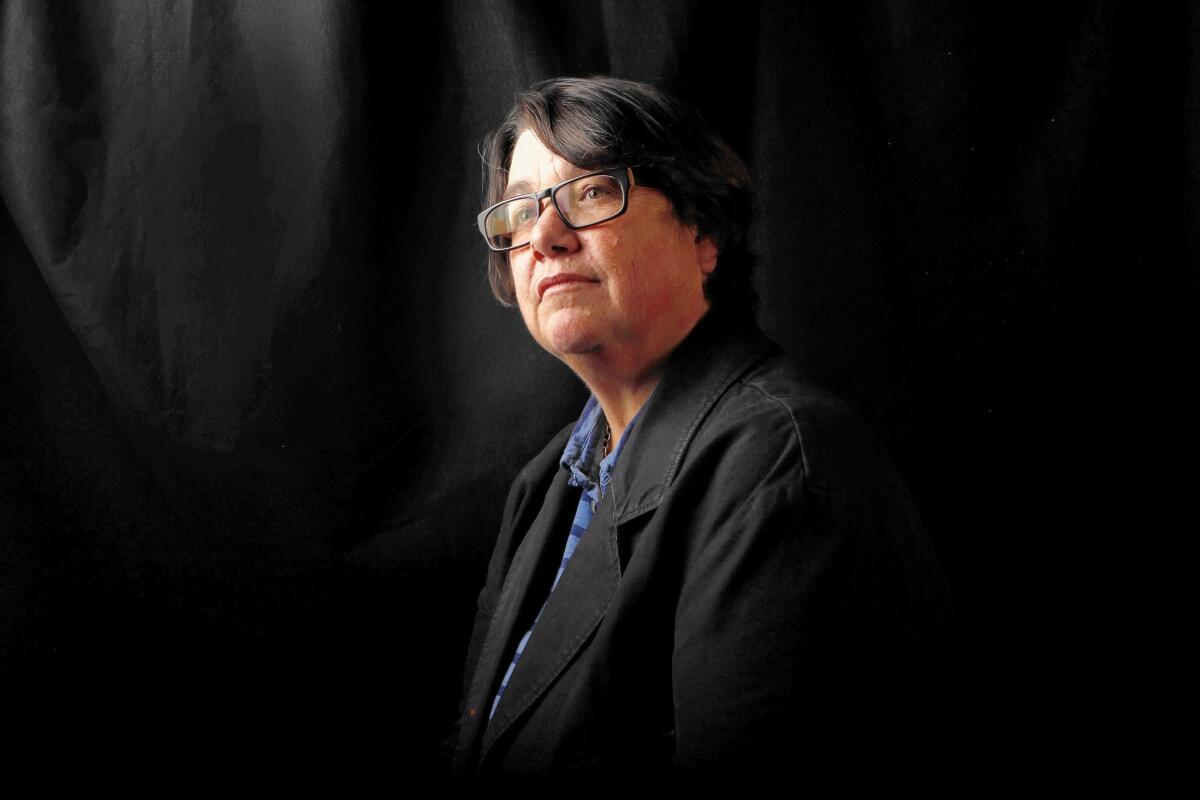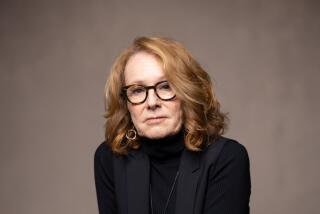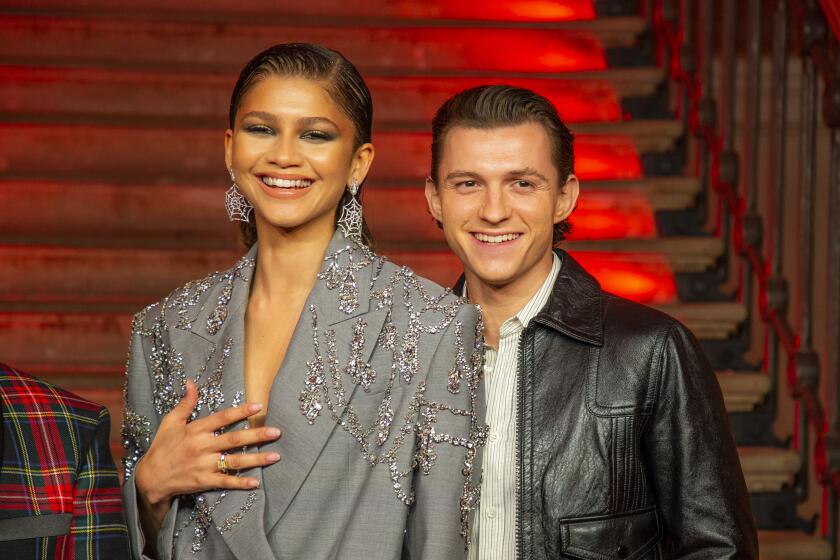A Catherine Opie moment in Los Angeles at MOCA and the Hammer

Catherine Opie is thinking about slowing down these days. Not creatively, by any stretch — the fine-art photographer will have one of the most visible moments of her career this week when two solo exhibitions open just eight days apart at the Museum of Contemporary Art and the Hammer Museum.
In private moments, however, Opie is ruminating about and embracing moments of pause. That could mean hours, alone in a national park, staring at a snow-capped mountain peak for inspiration, or long stretches of meditative silence on a road trip with her wife, Julie, and their 13-year-old son, Oliver; or downtime between teaching classes at UCLA, immersing herself in reading Rebecca Solnit, her favorite author.
Today, as Opie gives a languid tour of her West Adams art studio, pause means “racking the lens” — as she explains it, creating a blurry effect in a picture. She points to abstract landscapes hanging in her studio, a cottage-like space tucked behind the family’s 1908 Craftsman home. One picture shows fuzzy, rushing waterfalls; in another, falling snowflakes look like glimmering stars in space; a third is a hazy, ethereal lake bathed in blue light that’s more Manet painting than photograph. The quiet, fluid images are slightly unintelligible at first, so you aren’t immediately sure what you’re looking at.
“That’s the point. It creates this moment of pause,” Opie says, giving a wry smile. “We’re in such an intense moment of media saturation in terms of social media with photography. We go to the Grand Canyon, we take a picture on our cellphone, we post it on Facebook — ‘We’ve been there, boom, boom.’”
But by racking the focus, she says, “you may think you’re looking at Niagara Falls, but are you? You have to stop and think.”
Training her eye on social media habits and the pace of modern living is in line with Opie’s longtime role as documenter of American landscapes, whether they be physical, political or ideological. Toggling between portraiture, landscapes and studio photography in conceptual and documentary styles for more than 25 years, Opie’s work is often as much about the medium of photography as it is about her subjects. She’s also an anthropological chronicler of communities — high school football players, S&M bondage practitioners, Malibu surfers, public crowds during President Obama’s first inauguration, lesbian couples across the U.S. — and an explorer of individual identity within those milieus.
The MOCA and Hammer exhibitions continue in this tradition. They’re both portraiture shows about artists and the idea of celebrity. They both also have something to say about art and pause.
MOCA’s “Catherine Opie: 700 Nimes Road,” which opens Jan. 23, presents work that Opie shot over six months inside Elizabeth Taylor’s Bel-Air home. Opie wandered room to room, following the light, spending hours sifting through Taylor’s closets, shooting her silk suits, arranging her jewelry in different configurations and capturing the award trophies, the pillowy floral curtains and the lived-in furniture — even Taylor’s cat, Fang, gingerly stepping between Chanel shoes — to create a slow, nuanced portrait of the actress.
The MOCA show includes large-format images from the resulting “Closets and Jewels” series as well as work from a 50-image portfolio that Opie created as a limited edition, cloth-bound artisan box with embossed text. These images are among the 130 slates in Opie’s new book, “700 Nimes Road.”
Opie says the Taylor project came about because she and the actress shared an accountant, who offered an introduction. Opie was a fan of Taylor’s movies, and as an activist with Act Up and Queer Nation, Opie had long admired Taylor’s AIDS activism. She began shooting Taylor’s home in 2011, before the actress had died. Though the idea was always to shoot her things and not the actress herself, the trick was to give the objects a human quality.
“The scuff of the chair over the years on the wallpaper in the kitchen, the emery boards by her bed which hold markings and traces of her,” Opie says, “all of that is moments when the person is present.”
Taylor’s death midway through the project profoundly changed the work as well as Opie’s process. As Taylor’s estate was being disassembled, Opie’s photography took on a movement of sorts. She had been shooting static documentary photographs; suddenly, she had the opportunity for conceptual, staged work. Moments before Taylor’s jewelry was carted off to Christie’s, for example, Opie and Taylor’s assistant laid out the jewels on the couch in the sun for a series of abstract pictures.
“It was a moment of homage,” Opie says. “We would never have [done that] if she’d been alive.”
“Hammer Projects: Catherine Opie: Portraits,” which opens Jan. 30, consists of 12 studio portraits of well-known visual artists, writers and designers from Opie’s circle of friends and colleagues, plus one abstract landscape. Among them: Kara Walker, John Baldessari, Jonathan Franzen, Matthew Barney, Miranda July and Raymond Pettibon. Opie started the series about four years ago — it’s ongoing — and shot in her L.A. studio and in New York. She chose her subjects, in part, because they had faces she wanted to stare at for long periods of time.
There’s a painterly quality to the portraits. Faces or isolated objects glow in rich light as the rest of the composition seemingly melts into darkness. In one, artist Glenn Ligon looks off, melancholic, his face and neck seemingly disembodied and floating. Franzen appears from behind, flipping through a book; the pages pop, bathed in milky white light, while much of his body, in a dark suit, fades into the background.

Photographer Catherine Opie is preparing for two major museum shows at MOCA and the Hammer. She gives the L.A. Times a tour of her West Adams studio.
“I think of the black as almost a moment of subconscious, a dream state to a certain extent,” Opie says. “And again, that pause. Can an image sustain us for more than 30 seconds? There’s a moment when all photographs are an immediate read, but it’s that slowness of them over time that I really, really like.”
As different as the exhibitions are, there’s a definite synergy between them. Opie is nothing if not culturally contextual. A voracious reader, TV watcher and museum-goer — currently on the board of MOCA and formerly on the board of the Hammer — even the most casual conversation with the artist is studded with art history references. The MOCA show, she says, was inspired by William Eggleston’s photographs of Elvis Presley’s Graceland estate; the Hammer show is in conversation with her love of old-master portraiture. (She’d seen a Leonardo da Vinci exhibition at the National Portrait Gallery in London shortly before starting the body of work.) Both shows document artists — one a broad, horizontal take of Opie’s own artistic community and the other a narrow but deep dive into one entertainer’s life via her home and her stuff.
“She’s one of the most important inheritors and extenders of social documentary photography in the American tradition,” MOCA chief curator Helen Molesworth says. “She has an extraordinary capacity to take a picture of the world that allows us to see it with new eyes and to see the truth of the world as it’s being handed to us.”
Opie’s eye for documenting America was instilled early. Growing up in Sandusky, Ohio, Opie was part of a family who was passionate about art and politics, often having spirited dinner conversations about current events. She describes her young self as “a news junkie.” The family owned the craft supply factory OP Craft, but in his off time, Opie’s father amassed what was believed to be the country’s largest collection of American political memorabilia, which filled the house. After he died, much of the collection went to the Smithsonian Institution in Washington, D.C.
When Opie was 8, a Lewis Hine photograph that she saw in a school book gave form to what she had intuited about her life. She came home and declared to her parents that she was going to be a social documentarian photographer. For her birthday that year, her parents gave her a Kodak Retina camera.
The MOCA and Hammer exhibitions were conceived separately about a year and a half ago, the museums say. When Molesworth and Hammer chief curator Connie Butler realized the parallel, they moved forward in tandem, penning a joint press release about the shows and coordinating programming. The two will appear with Opie in conversation at the Hammer on Jan. 31.
“It’s a new day at these institutions, and the idea was, ‘Let’s try to collaborate when we can,’” Butler says. “We thought: ‘Let’s have a Cathy Opie Moment in L.A.’”
That moment will be ongoing. On Feb. 13, the Los Angeles County Museum of Art will show “Catherine Opie: O,” seven black-and-white images constituting Opie’s “O Portfolio,” shot in San Francisco’s bondage community and now part of the museum’s permanent collection. Opie intended the series to be in conversation with Robert Mapplethorpe’s 1978 photographs of gay male sadomasochism, the “X Portfolio.” The Opie exhibition is a prelude to LACMA’s March exhibition of “Robert Mapplethorpe: The Perfect Medium.”
Opie is also creating a six-story-high, segmented vertical landscape titled “Yosemite Falls” for the new Los Angeles Federal Courthouse on Hill Street in downtown L.A. The piece is set to debut this summer. And her New York gallery, Lehmann Maupin, is showing images from the Elizabeth Taylor and “Portraits” bodies of work.
Her next project will be an ode to her favorite movie, the photography-centric “La Jetée,” but she won’t reveal any details. She hasn’t begun work on it.
Instead, Opie is aiming to carve out moments of downtime, amid all the imminent attention, if that’s possible.
“I just have this incredible, passionate enthusiasm to figure out what it means to make images in my lifetime,” Opie says. “And to document and to stretch that. So if I’m asking people to slow down right now, it’s because I’m describing a certain aspect of what is going on in all of our lives.”
------------
Catherine Opie exhibitions
What: “Catherine Opie: 700 Nimes Road”
Where: MOCA Pacific Design Center, 8687 Melrose Ave., West Hollywood
When: Through May 8
Admission: Free
Info: (310) 289-5223, www.moca.org
+++
What: “Hammer Projects: Catherine Opie: Portraits”
Where: Hammer Museum, 10899 Wilshire Blvd., Westwood
When: Jan. 30 through May 22
Admission: Free
Info: (310) 443-7000, www.hammer.ucla.edu
+++
What: “Catherine Opie: O”
Where: Los Angeles County Museum of Art, 5905 Wilshire Blvd., Los Angeles
When: Feb. 13 through Sept. 5
Admission: $10-$15; 17 and younger free
Info: (323) 857-6000, www.lacma.org
More to Read
The biggest entertainment stories
Get our big stories about Hollywood, film, television, music, arts, culture and more right in your inbox as soon as they publish.
You may occasionally receive promotional content from the Los Angeles Times.











